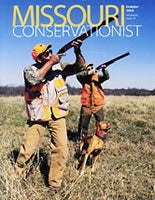Driven by cooling temperatures and shortening days, Missouri’s forests are about to undergo their annual spectacular color transformation. Soon the leaves of deciduous trees will abandon the monotony of green and explode in a riot of yellows and reds, golds and ambers.
Ironically, at nearly the same time that Missouri’s woods blaze with color, Missouri’s hunters shed their summer plaids and multicolored T-shirts and cloak themselves in camouflage patterns meant to suggest forest floors, marsh grasses or tangled brush.
The hunters remain drab until November, when they fluoresce into blobs of bright orange. You never get a sense of how many deer hunters there are in Missouri until you drive around in deer season and see all those hunter-orange coats and hats in cars, on the roads and in the woods.
I like the sight of all those hunters in the colors of their sport - camouflage or hunter orange - and I think they like to see me wearing mine. It’s rare when the driver of a vehicle, recognizing another hunter behind the wheel of an oncoming car, doesn’t exchange a wave of greeting. And knots of hunters often gather at service stations, cafes and rest areas to talk. Their camaraderie and connection seems immediate. It derives from a common bond, a shared mutual respect.
In light of this, I can’t help but question my editorial judgement when, a few months ago, I did not challenge an author’s suggestion in this magazine that camouflage clothing be worn only in the woods, never around town.
I let it pass because hunters - particularly bowhunters - should be concerned about the aromas their hunting clothes may carry. Deer have highly discriminating noses, and hunters soon learn that no scent is better than any scent. What you want to avoid most are the strong odors picked up from being around cars, tobacco or cooking.
I always wash my bowhunting jacket and pants in perfume-free detergent, hang them on a clothesline to dry and keep them stored in plastic bags with cedar boughs until I’m ready to walk into the woods.
The author’s statement made good sense from a hunting standpoint, but it wasn’t a practical tip that he was providing.
His intent was to encourage hunters to be wary of upsetting people who either don’t hunt or oppose hunting. He wanted hunters to take part in their sport invisibly - not camouflaged.
It’s not a bad idea to avoid riling other folks whenever we can. But it seems unfair to expect us to eliminate or reduce possible prickly reactions to hunting by changing out of our uniforms before appearing in public.
Imagine asking Chiefs or Rams fans not to wear their logo jackets and hats in restaurants or to school because the sight of them might upset someone who doesn’t care for football.
We have no reason to hide and every reason to be proud. Hunters, through their license fees and participation in the sport, have increased wildlife numbers and wildlife habitat. It’s not preposterous to claim that if there were no deer hunters, we might not have any deer. The same could be said of turkeys and waterfowl. Sport hunting fueled the restoration of these species and drives the management of current populations.
We have inherited a hunting tradition that provides us with pleasure, a sense of belonging and a portion of nature’s bounty. Let’s not imperil hunting - now or in the future - by failing to express our participation in it. Wear your hunting clothes with pride.
Tom Cwynar, Editor
And More...
This Issue's Staff
Managing Editor - Bryan Hendricks
Art Editor - Dickson Stauffer
Designer - Tracy Ritter
Artist - Dave Besenger
Artist - Mark Raithel
Photographer - Jim Rathert
Photographer - Cliff White
Staff Writer - Jim Low
Staff Writer - Joan McKee
Composition - Libby Bode Block
Circulation - Bertha Bainer






















